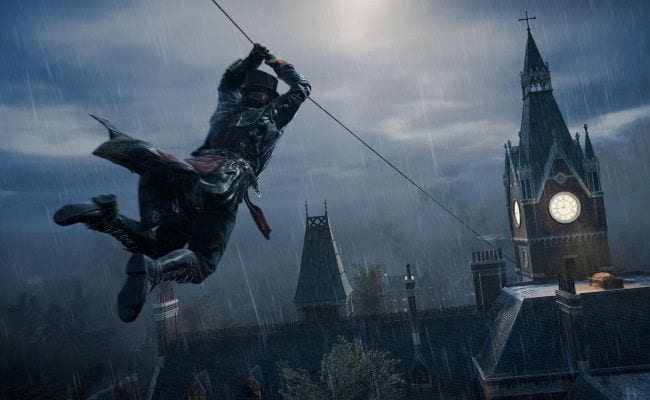
Some time ago I wrote a post praising Ubisoft for its dedication to climbing in the Assassin’s Creed games and Grow Home. I complained out loud that the grappling hook set to be introduced in Assassin’s Creed: Syndicate was just a concession to gamers who want to speed through an open world as fast as possible, treating the space as an obstacle to be passed rather than as an environment to be appreciated. Thankfully, that’s not the case. As it turns out, the grappling hook is really pretty awesome.
First of all, it’s a necessity. Industrial London is huge. Train stations are bigger than ancient palaces, smokestacks stand taller than castle spires, the average building towers above you like a titan, and the streets are so wide you could sail a boat through them with room to spare. In previous games I could traverse the city by leaping across rooftops, and even when that leap was too wide there would be a cable connecting the buildings, allowing me to avoid the ground like it was hot lava. But no human on earth could leap between the rooftops of 19th century London.
Modern cities are simply bigger than ancient cities because there’s more infrastructure. This is the first Assassin’s Creed with “cars” (i.e. carriages) and that means it’s also the first game with roads. Not just streets or paths or walkways, but roads that are designed to be traversed with large, bulky vehicles going both ways, which means multiple lanes per road. That infrastructure pushes buildings apart, making London a wider location than previous cities.
The grappling hook doesn’t really help us move through the city faster, it helps us move through the city at the same speed that we did in previous games, but because this city is so much wider, because we have so much more ground to cover, we have to move more efficiently through this space in order to match our previous speed.
In retrospect, this is also probably why the last game, Unity, which was set in modern Paris, made it so much easier to descend from structures. Previously, climbing down a building was an arduous process, and you more than likely just jumped off a roof even if it hurt you. The hit was worth the time saved, and our Assassin could survive a two story fall, though three stories was dangerous and four would kill you. Paris was a big city, and nearly every building was three or more stories tall. We could no longer jump off roofs without a care for our health. The scale of the city necessitated more efficient movement. This holds true for Syndicate as well, but this time the scale grows taller and wider.
In my last post, I worried that the hook would make climbing too easy, and lamented the loss of the “art of the climb,” as I always enjoyed watching my Assassins work their acrobatic skills. This does come to pass. One of the central uses of the grappling hook is climbing tall buildings in a single tool-assisted bound. However, I can’t lament that loss too much as the hook doesn’t really remove the “art of the climb,” but rather transplants it onto a horizontal plane. I’ve often found myself standing on a roof, scanning the city to the horizon, picking out potential grapple points on chimneys and signs, plotting a path through the city that lets me avoid the ground. This is similar to how we used to climb in the original Assassin’s Creed, when it was more of a puzzle. We’d look for handholds and maneuver around a tower until we found the proper path to the top. The grappling hook makes climbing overly simple, but still keeps the methodical movement that I love.
The environment has always been one of the best parts of an Assassin’s Creed game, and I’m grateful that the grappling hook wasn’t implemented in a way that would encourage people to ignore this wonderful space. The “art of the climb” may be gone, but the “art of movement” is still solidly intact.


![Call for Papers: All Things Reconsidered [MUSIC] May-August 2024](https://www.popmatters.com/wp-content/uploads/2024/04/all-things-reconsidered-call-music-may-2024-720x380.jpg)



